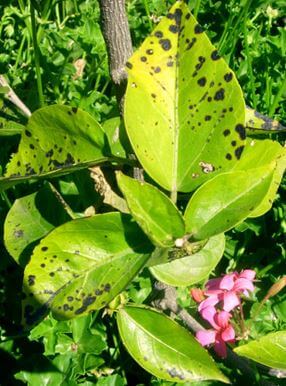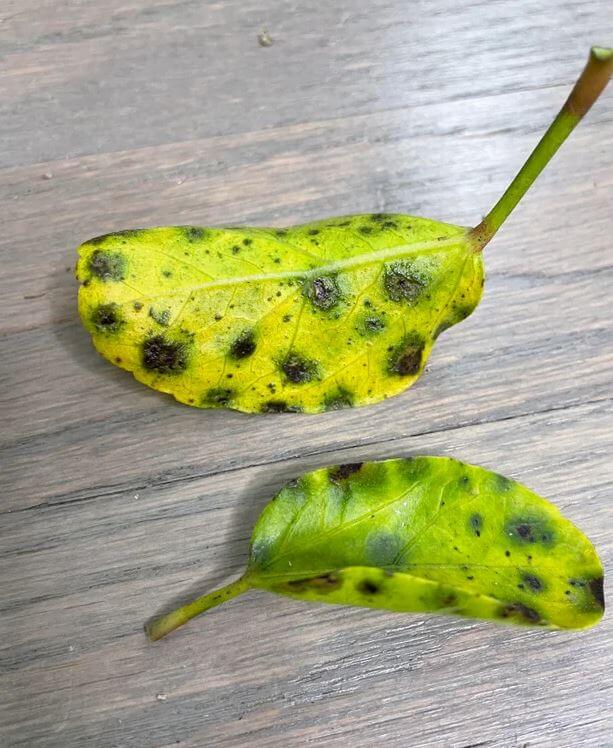Last Updated on September 9, 2023 by a Friendly Gardener
Hibiscus plants are well-loved among flowering garden plants. Members of the Malvaceae family find their natural habitats in tropical areas around the globe. Popular for the size, color, and aesthetic appeal of blossoms, this genus hosts more than 300 species.
But like all plants, the hibiscus has its share of challenges and potential health issues. So, when gardeners find black spots on hibiscus foliage, panic can easily be the initial reaction. Although they may be ugly and rather sinister looking, the appearance of black spots is a resolvable issue in most all cases.
What Causes Black Spots on Leaves of Hibiscus

There are two principal causes of black spots on hibiscus foliage:
-
Pest infestation
Infestations especially of aphids, scales, or white flies can be the cause of dark spots on hibiscus foliage. These pests typically deposit honeydew, which is sticky waste that these pests excrete. Honeydew often results in sooty mold forming which will cover leaves and stems leaving black leaves on hibiscus plants.
Beware of scale insects in particular. They often latch on to stems and leaf undersides. They are usually dark brown or black and can be mistaken for black spots. They will excrete honeydew which can lead to sooty mold.

-
Presence of bacteria or fungus
Dark spots happen because foliage has been wet for too long and has not had the opportunity to dry. They are common during damp and cooler weather conditions. The bacteria may not affect the rest of the plant and symptoms may be limited only to these black spots.
Bacterial leaf spots or fungal leaf spots can appear on the tops or undersides of foliage. You can prune heavily affected leaves and stems to speed up the repair process. Also, sweep up fallen leaves that are affected. Full or generous partial sunlight and fertile deep soil beds will help your plant recover from infections.
Do These Black Spots Damage My Hibiscus Plant?

These spots on hibiscus leaves will generally not cause any damage to the plant, regardless of the cause. Infections, whether bacterial or fungal in nature, are usually limited to the leaves where they appear, so damage is cosmetic rather than systemic.
In the case of sooty mold growth, the fungal infection is nourishing itself not on the plant but on the honeydew secretions. So, leaves are not damaged. Problems could arise if the sooty mold is allowed to proliferate as it will block sunlight from reaching leaves so that photosynthesis does not take place. When this happens, the plant will not be able to nourish itself and its general health can be compromised. The appearance of sooty mold on a hibiscus plant indicates that your plant has a serious pest infestation.
Pest infestations should not be underestimated as they can do serious damage not only to hibiscus plants but to other plants in your garden. They will eat holes in plant parts including stems, leaves, and even roots, deposit eggs, act as vectors for plant diseases, and in some cases suck the sap from plants. While bacterial or fungal infections on hibiscus may have limited consequences, pest infestations can have much more widespread and serious ramifications for your garden.
How to Treat Black Spots on Hibiscus Leaves

If the black spots are bacterial or fungal, you may not need to treat the spots. Because the fungus or bacteria may not affect the entire plant or permit the development of other symptoms. Often when the weather improves, these infections will die a natural death thanks to warmer temperatures and a dryer environment. The plant will drop infected leaves.
If you live in a relatively humid or rainy climate, prune any spotted leaves from your plant. Also, consider spraying your plant with an anti-fungal or anti-bacterial spray. Neem oil is an organic treatment that functions both as an insecticide and as a fungicide.
If you prune off infected areas, you need to destroy these plant arts to prevent the infection from spreading in your garden. You may want to prune your hibiscus plant to improve air circulation around the plant. Also, consider watering your hibiscus at the soil level rather than from overhead which will wet foliage creating the conditions for bacterial or fungal growth.
Pest infestations are trickier to overcome. Neem oil or another horticultural oil are good organic solutions for killing pests if you prefer to avoid chemicals. For extensive severe infestations, chemicals may be your only choice.
If you can eradicate a pest infestation, you will need to treat any affected leaves that have honeydew or sooty mold with insecticidal soap. Infestations require more time and effort to overcome, but once the pests are gone, you should see improvement. Sooty mold growth should also disappear.
Yellow Leaves on Hibiscus

Yellowing leaves can also be a problem for hibiscus plants. The causes are much different than those of black spotting on leaves. Yellowing foliage is generally attributable to:
-
Insufficient light
Ideally, a hibiscus needs full sunlight or generous partial light. Excessive harsh light can cause leaf scorching. A lack of sunlight means that the hibiscus cannot produce sufficient chlorophyll to maintain a green color. Ideally, try to provide full sun in the morning and shade in the afternoon.
-
Changes in Temperature or Humidity
Both extreme cold and heat can cause hibiscus foliage to yellow. Major changes in humidity levels will also cause leaves to yellow. If your climate has a harsh winter, consider moving your plant indoors.
-
Insufficient Nutrition
If your hibiscus has inadequate nutrition, it may develop iron chlorosis which will result in yellow leaves. Fertilize your hibiscus with a fertilizer formulated specifically for these plants and amend the soil so that the pH measures between six and seven.
-
Improper Watering
The hibiscus loves water, so too little as well as excessive watering can lead to yellowing leaves. Try to maintain the soil bed evenly moist and reduce watering in winter during dormancy. Soil should be well-draining.
-
Changes to the Environment
Transplanting or repotting your hibiscus will cause the foliage to yellow.
-
Pest Infestations
Pests such as mealybugs, aphids, or spider mites can turn leaves yellow. Spray your plant with insecticidal soap or neem oil if you notice any evidence of pests.

